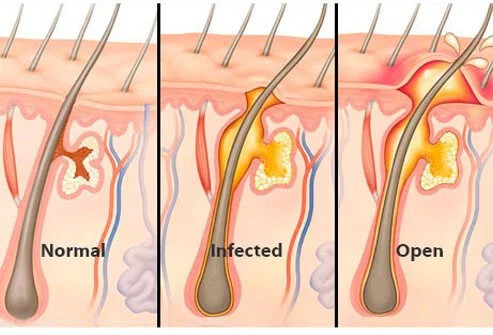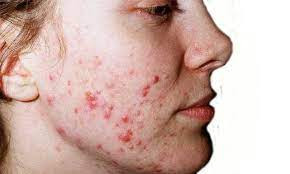Definisi
Acne rosacea atau rosacea adalah radang kulit yang bersifat kronis (jangka panjang) yang ditandai dengan warna wajah memerah (flushing, blushing), berjerawat, dan terlihatnya pembuluh darah pada wajah. Kelainan kulit ini terutama terlihat di area sentral wajah. Tanda dan gejala dari rosacea dapat terjadi selama beberapa minggu hingga beberapa bulan, lalu mereda untuk beberapa waktu, namun tidak sepenuhnya sembuh. Rosacea sering disamakan dengan jerawat (acne).
Rosacea bukan merupakan penyakit yang menular karena tidak disebabkan oleh kebersihan diri yang buruk, melainkan penyakit inflamasi (radang) pada kulit. Rosaea terkadang kerap didiagnosis sebagai jerawat sehingga tidak mengalami perbaikan saat diberi pengobatan. Rosacea terkadang melibatkan dengan penyakit kulit lainya seperti seborrhea, atau penyakit mata seperti radang pada mata (keratitis).
Rosacea dapat diderita oleh siapapun, namun lebih sering terjadi pada orang-orang yang berusia 30-60 tahun, terutama pada wanita paruh baya. Selain itu, jenis kulit yang lebih putih memiliki kerentanan mengalami rosacea. Tidak ada pengobatan yang efektif untuk rosacea, namun terapi dapat membantu meredakan gejala yang timbul.
Penyebab
Penyebab dari rosacea masih belum diketahui secara pasti, namun beberapa ahli menduga bahwa rosacea disebabkan oleh aktivitas sistem kekebalan tubuh yang berlebihan. Respon kekebalan tubuh yang tidak normal dapat menimbulkan peradangan serta pelebaran pembuluh darah dan pembuluh limfe. Pertumbuhan bakteri yang berlebihan pada kulit juga bisa berperan dalam timbulnya peradangan kulit.
Kombinasi dari faktor genetik (keturunan) dan faktor lingkungan juga dianggap berperan dalam timbulnya rosacea. Rosacea bukan disebabkan oleh masalah hygiene atau kebersihan diri, dan rosacea bukan merupakan kondisi yang menular.
Munculnya gejala secara tiba-tiba, atau terjadinya perburukan gejala pada rosacea diduga bisa dipicu oleh:
- Mengonsumsi makanan pedas dan minuman panas
- Mengonsumsi red wine atau minuman beralkohol lainnya
- Sedang berada pada lingkungan dengan suhu ekstrem
- Polusi udara atau asap rokok
- Paparan sinar matahari (UV) berlebihan
- Emosi
- Aktivitas fisik aerobik seperti berlari
- Obat-obatan yang dapat memicu pelebaran pembuluh darah, seperti obat-obatan tekanan darah
- Produk kosmetik, rambut, atau kulit
Faktor Risiko
Semua orang dapat mengalami rosacea, namun Anda memiliki risiko lebih tinggi untuk mengalami rosacea jika Anda:
- Wanita
- Memiliki kulit yang mudah terbakar oleh sinar matahari
- Berusia lebih dari 30 tahun
- Merokok
- Minum alkohol
- Memiliki anggota keluarga dengan riwayat rosacea
Gejala
Pada rosacea, biasanya ditemukan kemerahan pada wajah (blushing, flushing). Rosacea dapat menyebabkan kemerahan pada bagian sentral (tengah) wajah Anda. Kemerahan ini lebih sulit terlihat pada orang dengan kulit yang berwarna gelap. Selain itu bisa terlihat pembuluh darah di sekitar hidung dan pipi. Bisa ditemukan benjolan kecil serupa jerawat di area yang berwarna merah, benjolan tersebut dapat mengandung nanah. Kulit wajah bisa menjadi kering dan berkerak, serta dapat terasa rasa terbakar pada wajah.
Tidak hanya pada kulit wajah, gejala bisa muncul pada mata dan hidung. Gejala pada mata yang ditemukan dapat berupa mata kering, mata teriritasi, dan kelopak mata yang bengkak (ocular rosacea). Pada beberapa orang, gejala pada mata muncul terlebih dahulu sebelum gejala pada kulit. Hidung juga bisa terlihat membesar. Seiring berjalannya waktu, rosacea dapat membuat kulit di sekitar hidung menjadi lebih tebal sehingga hidung terlihat lebih besar (bulbous). Hal ini lebih sering terjadi pada pria dibandingkan wanita.
Gejala dari rosacea umumnya muncul secara bertahap, yaitu:
- Fase 1 (pre-rosacea), di mana kulit di sekitar pipi dan hidung menjadi lebih merah dan sedikit nyeri
- Fase 2 (fase vaskular), di mana kulit terlihat merah dan membengkak disertai kemunculan beberapa pembuluh darah
- Fase 3 (inflamasi atau peradangan), dapat terlihat jerawat atau pustul (jerawat berisi nanah) di sekitar area wajah yang mengalami kemerahan
- Fase 4 (lanjutan), yaitu fase penebalan kulit yang mengalami rosasea
Ada empat tipe dari rosacea, yaitu
- subtipe satu, dikenal dengan rosasea eritematotelangiektatik (ditandai dengan wajah merah, dan tampak pembuluh darah kecil pada wajah),
- subtipe dua, dikenal dengan rosasea papulopustular (dikaitkan mirip dengan jerawat namun tanpa ada komedo, biasanya pada wanita dewasa tua)
- subtipe tiga, dikenal juga dengan rinofima (bentuk jarang yang dihubungkan dengan penebalan kulit hidung, terjadi pada laki-laki)
- subtipe empat, dikenal juga dengan rosasea ocular (gejala klinis pada area mata seperti mata merah)
Diagnosis
Tidak ada pemeriksaan khusus yang dapat mendiagnosis rosacea. Dokter Anda akan melakukan pemeriksaan fisik dan menilai gejala yang Anda alami untuk menegakkan diagnosis rosacea. Pada beberapa kasus, Anda memerlukan pemeriksaan tertentu untuk membedakan rosacea dengan penyakit lain seperti lupus, psoriasis, reaksi alergi, atau dermatitis seboroik. Jika gejala yang Anda alami juga melibatkan mata, dokter dapat merujuk Anda ke spesialis mata untuk evaluasi lebih lanjut.
Tata Laksana
Pengobatan dari rosacea bertujuan untuk mengurangi keluhan serta gejala yang Anda alami. Terapi dilakukan dengan perawatan kulit yang baik serta mengonsumsi obat-obatan yang diresepkan oleh dokter. Pengobatan yang paling efektif dari rosacea adalah menghindari faktor pencetus yang membuat gejala muncul atau semakin memburuk.
Obat-Obatan
Dokter dapat meresepkan obat krim serta obat jerawat untuk mengatasi keluhan Anda. Bila ditemukan tanda infeksi bakteri pada keluhan kulit Anda, dokter bisa memberikan antibiotik untuk menangani infeksi. Jika jerawat yang terjadi cukup parah, dokter Anda juga dapat meresepkan obat-obatan pereda jerawat seperti isoretinoin. Obat ini cukup poten, namun tidak boleh dikonsumsi oleh ibu hamil.
Terapi Laser
Terapi laser dapat membantu meredakan pembuluh darah yang besar. Konsultasikan pilihan terapi laser dengan dokter Anda. Efek samping dari terapi laser untuk rosacea antara lain adalah pembengkakan dan kemerahan pada wajah selama beberapa hari. Mengompres bekas laser menggunakan kain yang dingin dapat membantu mengurangi gejala tersebut selama masa penyembuhan. Efek dari terapi laser dapat terlihat setelah beberapa minggu pasca tindakan. Laser perlu diulang untuk mempertahankan kualitas kulit Anda.
Perawatan Diri di Rumah
Anda bisa makukan langkah-langkah di bawah ini untuk meredakan gejala dari rosacea, yaitu:
- Carilah faktor pencetus dari rosacea yang Anda alami, contohnya aktivitas fisik atau konsumsi kafein, lalu hindari faktor pencetus tersebut
- Gunakan tabir surya dengan SPF 30 setiap harinya
- Hindari lingkungan yang panas atau terlalu lembap
- Lindungi wajah Anda pada udara dingin
- Gunakan produk perawatan kulit (skincare) yang lembut atau diperuntukkan untuk kulit sensitif
- Bersihkan kelopak mata Anda setidaknya satu kali sehari jika Anda mengalami blefaritis (peradangan pada kelopak mata)
- Hindari stres
- Jika Anda tidak nyaman dengan kemerahan yang ditimbulkan oleh rosacea, Anda dapat menggunakan produk makeup untuk menutupi flushing tersebut, jangan lupa untuk rutin membersihkan makeup setelah beraktivitas
- Hindari menggosok kulit Anda terlalu keras ketika membersihkannya dengan pembersih wajah agar tidak iritasi
Komplikasi
Komplikasi utama dari rosacea yang tidak ditangani adalah:
- Phymatous rosacea (Rhinophyma), yaitu perubahan bentuk hidung menjadi lebih besar dan keras akibat perubahan kulit di sekitarnya. Rhinophyma tidak dapat ditangani hanya dengan obat-obatan. Dokter dapaat melakukan prosedur dermabrasion untuk menipiskan lapisan kulit dengan terapi laser atau operasi
- Penyakit peradangan mata seperti keratitis atau konjungtivitis (peradangan pada lapisan konjungtiva mata)
- Rasa tidak percaya diri yang mengganggu diri dan hubungan penderita dengan lingkungannya, seperti menjadi cemas, depresi, kurang percaya diri, isolasi sosial
Orang yang memiliki rosacea diketahui sering mengalami tekanan darah tinggi, penyakit kardiovaskular, dislipidemia (peningkatan kadar kolesterol dalam darah), diabetes melitus, sakit kepala migrain, demensia, kolitis (peradangan lapisan usus besar), rheumatoid artritis, dan infeksi Helicobacter pylori.
Pencegahan
Setelah identifikasi faktor risiko yang anda miliki, langkah berikutnya adalah perbaikan faktor risiko yang dapat diperbaiki. Berikut langkah-langkah yang dapat anda lakukan:
- Hindari makan makanan yang panas atau pedas
- Hindari paparan sinar matahari yang terlalu lama
- Bagi perokok, sebaiknya mulai berhenti merokok.
- Batasi minum minuman beralkohol bila perlu boleh untuk dihentikan dan digantikan dengan meminum air putih sebanyak 2 liter per hari atau 8 gelas per hari
- Hindari olahraga yang terlalu berat
- Istirahat yang cukup, sekitar 6-8 jam setiap hari.
- Kelola stress emosional
- Gunakan tabir surya bila pergi ke luar rumah
- Gunakan produk perawatan kulit yang lembut
- Hindari produk perawatan kulit yang mengandung alcohol, mentol, witch hazel, atau agen eksfoliasi
- Gunakan pelembap wajah
- Jangan lupa untuk mengikuti regimen obat Anda sesuai arahan dokter
Langkah untuk mencegah flare-up dari rosacea antara lain:
- Lindungi wajah Anda dari matahari dengan topi atau tabir surya SPF 30
- Kurangi stress dan temukan langkah manajemen stress yang efektif untuk Anda
- Hindari suhu yang terlalu tinggi (mandi dengan air hangat dan bukan air panas, minum minuman dingin, menggunakan pendingin ruangan)
- Lihat respon kulit Anda terhadap alkohol, makanan pedas, dan kafein
- Berhati-hati dalam menggunakan produk rambut maupun produk kulit
- Jika Anda menduga Anda mengalami rosacea, segera periksakan kondisi ini ke dokter untuk mencegah komplikasi lanjutan
Kapan Harus ke Dokter?
Jika Anda mengalami gejala terus menerus pada wajah atau mata, Anda dapat memeriksakan kondisi ini ke dokter spesialis kulit untuk mendapatkan pengobatan yang sesuai.
Segera kunjungi IGD jika Anda memiliki rosacea dan Anda mengalami:
- Nyeri pada mata
- Pandangan buram
- Sensitif terhadap cahaya
- Mengalami mata merah
Gejala tersebut bisa menjadi tanda dari keratitis atau peradangan pada kornea mata yang memerlukan penanganan medis segera.
Mau tahu informasi seputar penyakit lainnya? Cek di sini, ya!
- dr Hanifa Rahma
- dr Anita Larasati Priyono
Mayo Clinic. (2021). Rosacea. Available from: https://www.mayoclinic.org/diseases-conditions/rosacea/diagnosis-treatment/drc-20353820
Keri, J. (2022). Rosacea. MSD Manual Consumer Version. Available from: https://www.msdmanuals.com/home/skin-disorders/acne-and-related-disorders/rosacea?query=Rosacea
Healthline. Rosacea. October 2019. https://www.healthline.com/health/skin/rosacea
WebMD. Rosacea. September 2021. https://www.webmd.com/skin-problems-and-treatments/understanding-rosacea-basics
Medline Plus. Rosacea. July 2021. https://medlineplus.gov/ency/article/000879.htm
Medscape. Rosacea. June 2021. https://emedicine.medscape.com/article/1071429-overview
Kuo, O. (2022). Rosacea. DermNet NZ. Available from: https://dermnetnz.org/topics/rosacea
National Health Service. (2020). Rosacea. Available from: https://www.nhs.uk/conditions/rosacea/
American Academy of Dermatology Association (AAD). (2022). How to prevent rosacea flare-ups. Available from: https://www.aad.org/public/diseases/rosacea/triggers/prevent
Farshchian M, Daveluy S. Rosacea. [Updated 2021 Dec 30]. In: StatPearls [Internet]. Treasure Island (FL): StatPearls Publishing; 2022 Jan-. Available from: https://www.ncbi.nlm.nih.gov/books/NBK557574/












